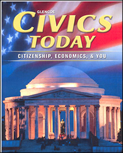
Civics Today Citizenship, Economics, & YouChapter 6: The Legislative BranchChapter OverviewsArticle I of the U.S. Constitution describes the legislative branch. Congress is a bicameral body made up of the House of Representatives and the Senate. In each house the political party to which more than half of the members belong is called the majority party. The other party is called the minority party. At the beginning of each term, the party members in each house choose leaders to direct their activities. Each term more than 10,000 bills are introduced to Congress. Bills are assigned to committees where they are studied, amended, pigeonholed, or killed. If reported favorably a bill is debated and voted on in the House or Senate. Finally, bills are sent to the president for approval or veto. Most of Congress's powers are related to making laws. However, Congress also has nonlegislative powers, such as proposing amendments and impeaching federal officials. |  |















